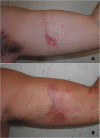Metastatic eccrine porocarcinoma: report of a case and review of the literature
- PMID: 21410982
- PMCID: PMC3068113
- DOI: 10.1186/1477-7819-9-32
Metastatic eccrine porocarcinoma: report of a case and review of the literature
Abstract
Eccrine porocarcinoma (EPC) is a rare type of skin cancer arising from the intraepidermal portion of eccrine sweat glands or acrosyringium, representing 0.005-0.01% of all cutaneous tumors. About 20% of EPC will recur and about 20% will metastasize to regional lymph nodes. There is a mortality rate of 67% in patients with lymph node metastases. Although rare, the occurrence of distant metastases has been reported.We report a case of patient with EPC of the left arm, with axillary nodal involvement and subsequent local relapse, treated by complete lymph node dissection and electrochemotherapy (ECT).EPC is an unusual tumor to diagnose. Neither chemotherapy nor radiation therapy has been proven to be of clinical benefit in treating metastatic disease. Although in the current case the short follow-up period is a limitation, we consider in the management of EPC a therapeutic approach involving surgery and ECT, because of its aggressive potential for loregional metastatic spread.
Figures




References
-
- Rare Care - Surveillance of Rare Cancers in Europe. http://www.rarecare.eu/
-
- Pinkus H, Mehregan AH. Epidermotropic eccrine carcinoma. A case combining features of eccrine poroma and Paget's dermatosis. Arch Dermatol. 1963;88:597–607. - PubMed
Publication types
MeSH terms
LinkOut - more resources
Full Text Sources

